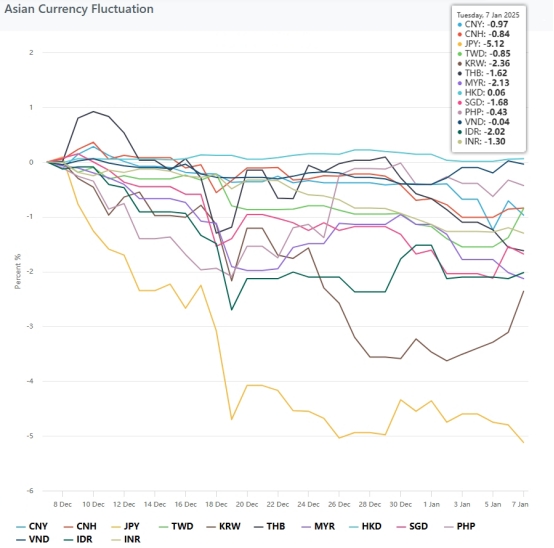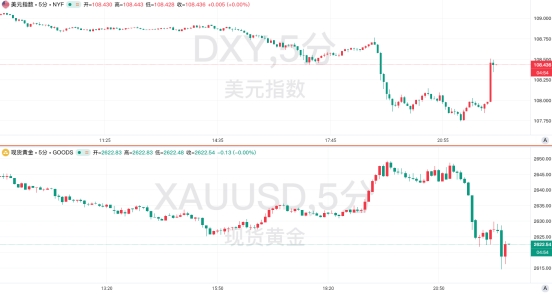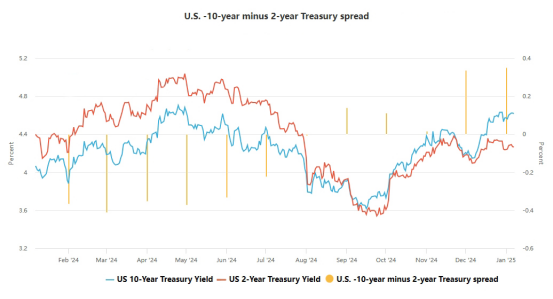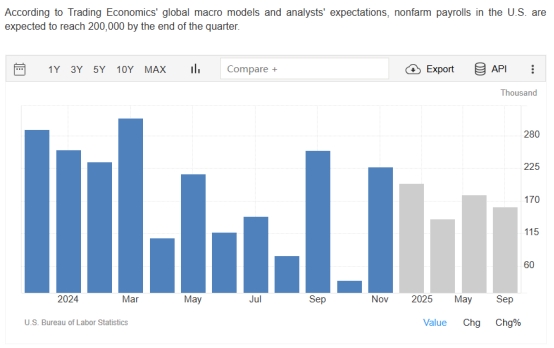Asian currencies are under pressure and the U.S. bond market is volatile, and the strong dollar environment is causing waves
- 2025年1月14日
- Posted by: Macro Global Markets
- Category: News

Asian currencies have generally fallen to their lowest levels in 20 years recently, mainly due to the strong growth of the US dollar and the vow of US President-elect Trump to raise tariffs. The Bloomberg Asian Currency Index fell to 89.0409 on Monday, its lowest level since 2006. Asian currencies have been pressured by a broad dollar rally as Federal Reserve officials remain cautious about the path of interest rates and investors worry that Trump's tariffs could lead to inflationary pressures.
The dollar will continue to rise across the board against Asian currencies, but some pairs will see greater upside. He pointed out that if US trade protectionism becomes a reality, it would be a huge game changer. Asian central banks may respond to this protectionism by allowing their currencies to depreciate in a controlled manner.

At the same time, Trump "refuted rumors" on social media, and The Washington Post reported that reports that Trump's aides were exploring a tariff plan that would apply to "all countries" but only cover key imported goods were false. This statement caused the US dollar index to rise 50 points in the short term, spot gold fell nearly $13 in the short term, and non-US currencies gave up some of their gains during the day, which marked a significant narrowing of the 10% to 20% general tariff proposed by Trump during the campaign. . Investors therefore increased their bets on a rate cut from the Federal Reserve on speculation that the new plan would not stoke inflation like previous sweeping tariff proposals. Influenced by this news, the US dollar index continued to fall, breaking through the 108 mark and falling nearly 1% on the day. Spot gold turned positive during the day, approaching the $2,650 mark at one point. Non-US currencies also collectively counterattacked, with GBP/USD, EUR/USD, NZD/USD and AUD/USD rising by more than 1%, while USD/JPY erased its intraday gains. The offshore RMB continued to strengthen against the USD, breaking through the 7.33 mark. It rose nearly 300 points during the day.

Markets are unnerved by the prospect that the U.S. government will issue $119 billion in new bonds this week. On Monday, the United States will issue $58 billion in three-year Treasury bonds, and will auction 10-year and 30-year Treasury bonds on Tuesday and Wednesday, respectively. Due to the state funeral of former US President Carter on Thursday, the average daily bond auction in this round is The adjustment hit longer-dated U.S. debt the hardest, with the benchmark 10-year Treasury yield rising to more than 4.6%, about a percentage point higher than when the Fed first began easing monetary policy in September. The yield on the 30-year U.S. Treasury bond rose to 4.85% at one point, the highest level since the end of 2023. The volatility of the two-year U.S. Treasury bond was more moderate, reflecting investors' shift to bonds that are more affected by the Federal Reserve's policy rate.

Meanwhile, Federal Reserve Governor Tim Cook said on Monday the Fed could proceed cautiously in further cutting interest rates given the economy is solid and inflation is proving more stubborn than previously expected. Since the Fed began cutting its benchmark interest rate in September, "labor market flexibility has increased, while inflation has been more stubborn than I expected at the time," Cook said in a speech at the University of Michigan Law School. "We think we can be more cautious with further rate cuts." The Fed cut its policy rate by a full percentage point in its final three meetings through 2024, but markets expect it to do so at its next meeting on Jan. 28-29. The Fed will keep its policy rate in the current range of 4.25% to 4.5%.

In 2025, the global economy and financial markets will continue to face multiple challenges. Asian currencies were under pressure from a strong dollar and uncertainty over Trump's tariffs, while the U.S. bond market was weighed down by the resilience of the U.S. economy, inflation expectations and policy changes. Investors need to pay close attention to economic data, policy trends and changes in market sentiment in order to respond to possible fluctuations and uncertainties.
